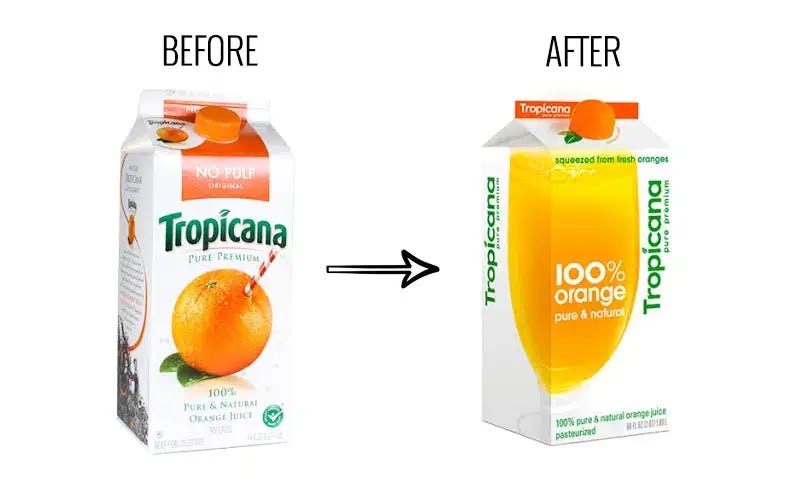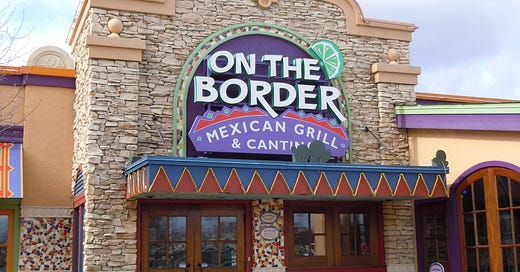Don't let the mob tell you your new logo is terrible (though it might be and maybe you should listen to them)
And be careful with stereotypes - you may say something gross...
Hello Gobbledeers,
How’s it going? Nice to be able to go outside and not be miserable, yes?
Before we jump in today - just a friendly reminder that if you’re looking for messaging help, that’s literally (actually literally, not figureatively literally) what I do for companies. I’m pretty sure your homepage isn’t where you want it to be (messaging-wise…I mean, it’s your homepage so it’s - again, literally - where you want it to be. On your home page. So your homepage being on your home page is OK. That’s good. It shouldn’t be elsewhere. But if what you’re SAYING on your homepage is confusing, I can help you with that. In fact, don’t tell anyone, I would LIKE to help you with that. I’m at jared@sagelett.com).
OK enough of that.
Today, we’ve got:
Be careful with stereotypes (because you might say something gross)
I read a scholarly journal article and tell you about it so you don’t have to read the article.
More adventures in re-branding, vowel edition.
Oh, and if I haven’t said it in a while - I really appreciate the feedback the Gobbledeers have given me. The weird thing about writing is that you don’t really know if people like it - a few of you have written really nice stuff to me recently, which I both needed to hear and very much appreciated. Thank you.
Liquid Ass-ets
I should state this up front:
Stereotypes are terrible. Just terrible.
Well, also sometimes they are true.
Both those things can be correct: They can be terrible, AND they can be true.
Or maybe they’re NOT true. That’s also one of those things about stereotypes - they can be terrible and they can be not true.
But also, it doesn’t really matter. True, not true, sorta true. That’s not really important.
One of the good things about having a brand that has a strong identity behind it is that your prospects and customers already have a shorthand to understand your brand. One of the bad things about having a brand that has a strong identity behind it is that your prospects and customers already have a shorthand to understand your brand.
This is especially true for restaurant chains that offer an ethnic-specific type of food. If you happen upon a Panda Express, for example, there may be stereotypes about Chinese food (not true, obviously!) that may cross the mind of the customer. And, in turn, the company needs to be aware of these to make sure that any of their public-facing communications do not inadvertently reinforce any of those stereotypes.
In another example, imagine you work for On the Border Mexican Grill and Cantina, a restaurant chain that sells, obviously, Mexican* food.
(*inspired. Mexican-inspired.)
Now, there are certain unfair (very unfair! and untrue - very mostly untrue!) stereotypes about Mexican food. Specifically, about how one may feel after eating Mexican food.
I, for one, am horrified by some of these stereotypes and have not found them to be true. For the most part. Also, my freshman year in college I swore to myself (and whoever was sitting near me at 2:45am) that I would never eat Taco Bell again. Of course, Taco Bell is to “Mexican food” as Anora is to “movie I would love to watch while sitting next to my parents,” but even so, there are certain connotations to Mexican food and its relationship to intestinal response that, if you worked for that company, you would want to keep in the back of your mind when you put out public-facing statements.
On The Border Mexican Grill & Cantina became the latest US casual-dining chain to file for bankruptcy amid surging labor costs, falling customer traffic and inflationary pressures…OTB Chief Restructuring Officer Jonathan Tibus wrote in a separate court filing [that] a “rapid loss of liquidity” in recent months prompted the company to not pay certain bills…
A rapid loss of liquidity was also why I swore off Taco Bell.
(I’m sorry…I’m sorry for that whole thing.)
What’s in a (Nick)name?
In this week’s edition of “I read a scholarly journal article so you don’t have to” (or as you Gobbledeers call it, IRASJASOYDHT), here’s an interesting piece of research about brands that use nicknames for themselves in their marketing (“MickyD’s” vs McDonald’s or “Bloomie’s” vs Bloomingdale’s).
The authors of “BMW Is Powerful, Beemer Is Not: Nickname Branding Impairs Brand Performance” in the Journal of Marketing found that brands that refer to themselves using nicknames in their marketing weaken the brand in the eyes of their customers. The idea is that by using a nickname that consumers have come up with, the brand is ceding some of its power to customers, and making the brand, itself, less powerful.
They write:
When Nordstrom revamped its loyalty program in 2018, the company announced that a key change was to rename it “The Nordy Club” in honor of the brand's long-standing nickname... In their social media activities, many brands make use of their nicknames such as BMW (e.g., “You can call us Bimmer, we’re friends at this point”; BMW USA 2020) and Cumberland Farms (e.g., “Coffee comes and goes, but Cumby’s is forever”; Cumberland Farms 2023).
(I mostly included that because someone who lives in my apartment told me that in college their nickname for Cumberland Farms was, hm, this is a family publication, uh, they used the first 3 letters of Cumberland and then “Farms,” which I don’t know, don’t shoot the messenger, I guess?)
That type of farms, aside, the authors found that this effect is especially pronounced for brands that are viewed as having a “competent” brand personality - these are brands that are seen as being “reliable, efficient and capable” - software brands, for example.
I’m not exactly sure what to do with this, but I found it interesting. Probably don’t use a nickname for your brand.
Carry on.
Vowel Movement
We’ve talked a bunch about rebranding and the pitfalls of it, and I think two things are true:
Re-branding is very challenging to get right.
The initial backlash that always follows a re-branding is actually overblown.
2b. After a little digging it looks like half the time I write “re-branding” and half the time I write “rebranding.” I should probably make up my mind.
The story that’s often trotted out when there’s a supposed rebranding fiasco is about the citrusy folks at Tropicana in 2009 rolling out new packaging for their orange juice cartons, only to have the world unanimously revolt against the beverage purveyors, and then the cowardly marketers gave in to the mob and brought back the old package:

So really you have two options if you choose to do a re-branding:
Ignore the mob and stick with the new branding.
Apologize to the mob (we didn’t know you had deep feelings for a cardboard container) and go back to the old branding. Also:
I guess there’s actually a 2b, which is “ignore the mob for a while, then give in to the mob.”
What would 2b look like? I’m glad you asked.
If you’re the British financial services firm previously known as Aberdeen, it looks like this:
You acquire a bunch of other companies and decide (not wrongly! this wasn’t a bad idea!) that you should take the five different brand names that you have and unify them under one new brand name. Not crazy.
Here are your options (marketers always have options):
Just roll them up under the Aberdeen name, and use the product line as part of it. Meaning you’d have Aberdeen Investments, Aberdeen Advisor, and so on.
Come up with a brand new name that reflects something something something - you call it Financiary (or whatever).
You use the Aberdeen, but make it “modern” in some way that will absolutely upset people.
Obviously they chose #3.
In 2021, they undoubtedly went to a branding firm and wrote that firm a check for an amount of money that you would make you want to vomit up Taco Bell.
Then the firm came back and said, “What if you made it all lowercase and removed the vowels?”
The answer, of course was, “absolutely!”
Behold, abrdn.
And as any 13 year old Jewish child can tell you, it’s virtually impossible to read text that has no vowels (unless you get a party at the end of it.)*
(*unnecessarily specific reference)
As the press release announcing the new brand stated, “Our new name reflects the clarity of focus that the leadership team are bringing to the business as we seek to deliver sustainable growth…”
Somehow removing the vowels did not bring clarity.
An absolute shtshw of press followed, leading the company’s chief investment officer to announce that, “I understand that corporate bullying to some extent is part of the game with the press, even though it’s a little childish to keep hammering the missing vowels in our name…Would you do that with an individual? How would you look at a person who makes fun of your name day in day out? It’s probably not ethical to do it. But apparently with companies it is different.”
I would say that bullying a company’s name IS different than bullying, say, a human being, but what do I know? Also, it pains me that the CIO’s name isn’t Dick, because then I would understand what got him all riled up here.
Anyway, fast forward 3 years and this week the company annncd, sorry announced, that it will go back to being “aberdeen” (lowercase ‘a’) because it was time to “remove distractions” (3 years!).
Whew.
As always, thanks for reading to the end. It’s the best part. If you’d like to chat about marketing or about when you swore off Taco Bell, here’s my Calendly link - it’s great chatting with readers. (I make this offer to chat sincerely - people really, actually do sign up to chat.)







One obvious sign of an awkward rebrand is when you have to coach people how to pronounce your new name in the press release announcing the rebrand. More awkward still when the new name is pronounced exactly the same as the original name.
I can't tell anyone at work that my favorite marketing newsletter is Gobbledy, because then they'll open your latest article to check it out and read the first section to get a feel for the content only to find 2178 characters of writing that are just the setup for a poop joke.